Sandibe Okavango Safari LodgeWall Section
由专筑网雷军,杨帆编译
借助于当地的工艺,Plewman建筑师在博茨瓦纳创造了一个可持续发展的旅游胜地,使即兴的设计与木材结合于一体。
Nicholas Plewman Architects creates a sustainable resort in Botswana through local craftsmanship, design improvisation, and a medley of timber.
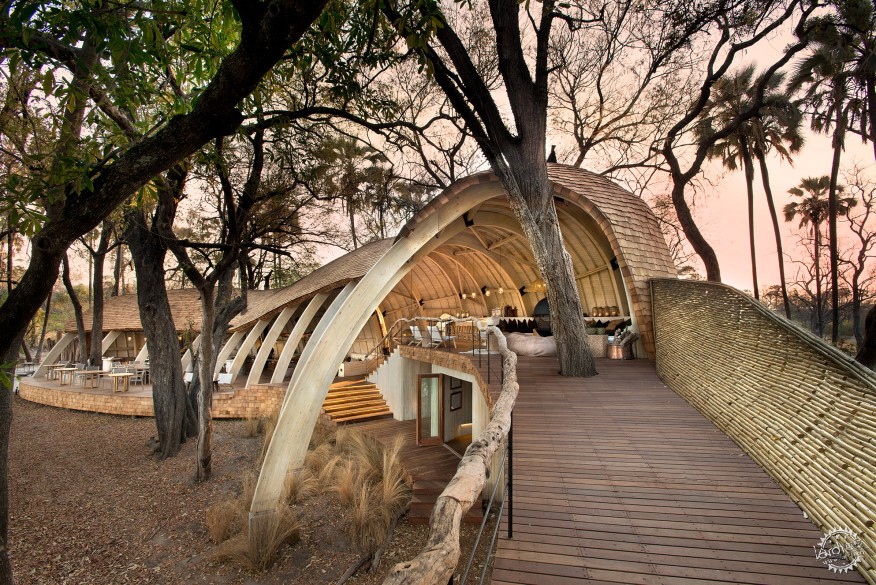
从空中看,奥卡万戈河流域流经博茨瓦纳北部的干旱草原,与纳米比亚以东约50英里处交界。喀拉哈里盆地青翠的水道和湿地形成了唯一的一个内陆河流三角洲的地域。作为联合国教科文组织在2014年认定的世界遗产,这是一个生态景观极其丰富又美丽的地方。Plewman被委任在此设计一个豪华度假村。
该地区是Plewman熟悉的领域,他在南非约翰内斯堡的同名公司的董事,在16年前创建了现今的产业。该地区的地标性突出,然而,对于11500平方英尺的场地,严格的设计和施工受到了局限,其中包括12个独立的平房和一个旅馆,一个餐厅和休息室。几乎所有的建筑材料都必须是可降解的,而垃圾的处理也必须在这选址内。
设计团队包括总部设在伦敦的博伊德米凯利斯联营公司。Plewman说“可生物降解的木材是必不可少的建筑材料。”团队的灵感来自博茨瓦纳的土著人Bayei木工以及动物。Plewman说,“把他们的住所与编织材料组合在一起,”像穿山甲的鳞片和织巢鸟,能建精细的巢。
From the air, the Okavango River valley is a green gash through the arid grasslands of northern Botswana, about 50 miles east of the Namibian border. The verdant canvas of waterways and wetlands fans out across the Kalahari Basin, forming one of the only inland river deltas in the world. It was within this ecologically rich landscape—inscripted as a UNESCO World Heritage Site in 2014—that Nicholas Plewman was commissioned to design a luxury resort with minimal site impact.
The region is familiar territory for Plewman, the director of his namesake firm in Johannesburg, South Africa, who had built the property’s existing lodge 16 years before. The area’s landmarked status, however, imposed severe design and construction limitations on the new 11,500-square-foot resort, which includes 12 freestanding bungalows and a lodge, with a restaurant and lounge. Nearly all building materials would have to be biodegradable, and waste from the resort would have to be treated on site.
The design team, which included London-based architecture firm Michaelis Boyd Associates, turned to wood. “Timber became the necessary building material because of its biodegradability,” Plewman says. The team drew inspiration from the carpentry of Botswana’s indigenous Bayei people as well as animals that Plewman says either “carry their shelter with them or weave it from the organic materials on hand,” like the scaly pangolin and the sociable weaver, a small bird that builds elaborate, communal nests.
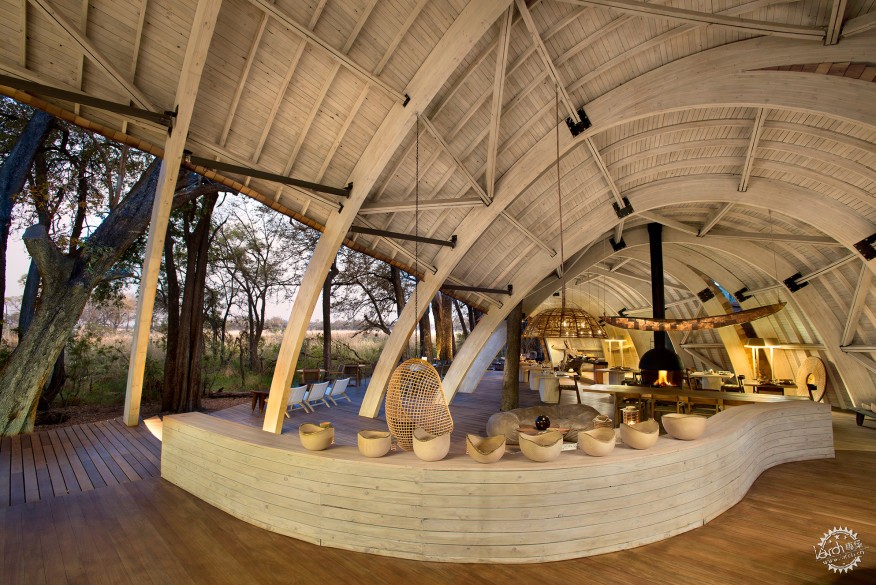
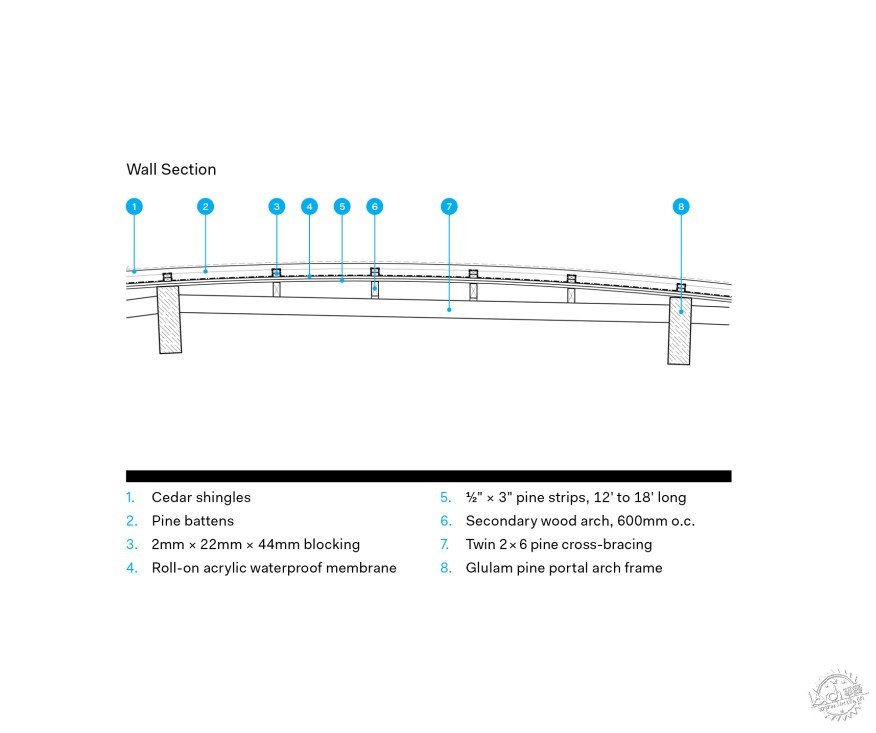

这样能使一个家庭变得亲密,木瓦结构在河岸景观和闭塞的网格构中基本是看不到的。主体建筑是起伏的、有点兽性的结构,风从灌木丛和木材中贯穿而过。Plewman说还包括松树、杉树、桉树等,其中大部分是本地采购。该设计还为原来的小屋搭建扶手和高跷来提高平房的高度,是预防该地区的季节性洪水灾害的必要措施。
位于森林的地面峰值27英尺高处,小屋由倒置的大抛物线性门式刚架,以及胶合松支撑建造而成。框架固定在混凝土地基,应生物降解材料要求和交叉双松2x6s支撑。二拱肋浸泡在附近的河流里,起对接作用的松木条,形成结构的木皮,“像船一样的木料,“Plewman说。这木板由滚丙烯酸防水膜和雪松木瓦制成,由于其有限的可用性而从加拿大进行采购。
The result is a family of intimate, wood-shingled structures that nearly disappear into the riparian landscape and operate off the grid. The main building, an undulating, animalistic structure, winds through a copse of trees and comprises a “cocktail of timber,” which Plewman says includes pine, cedar, eucalyptus, and massaranduba, much of which was sourced locally. The design also repurposes leadwood limbs from the original lodge as handrails and stilts to elevate the bungalows, a necessity during the area’s seasonal flooding.
Rising 27 feet from the forest floor to its peak, the lodge is essentially an upside-down hull supported by large parabolic portal frames made from glulam pine. The frames are bolted to concrete footings—which were exempted from the biodegradable material requirement—and cross-braced with twin pine 2x6s. Secondary arch ribs, soaked in a nearby river and bent on-site, help support the butt-jointed pine strips that form the structure’s wooden skin, “like the timbers of a boat,” Plewman says. This plank sheathing is finished with a roll-on acrylic waterproof membrane and cedar shingles, which were sourced from Canada because of its limited availability locally.
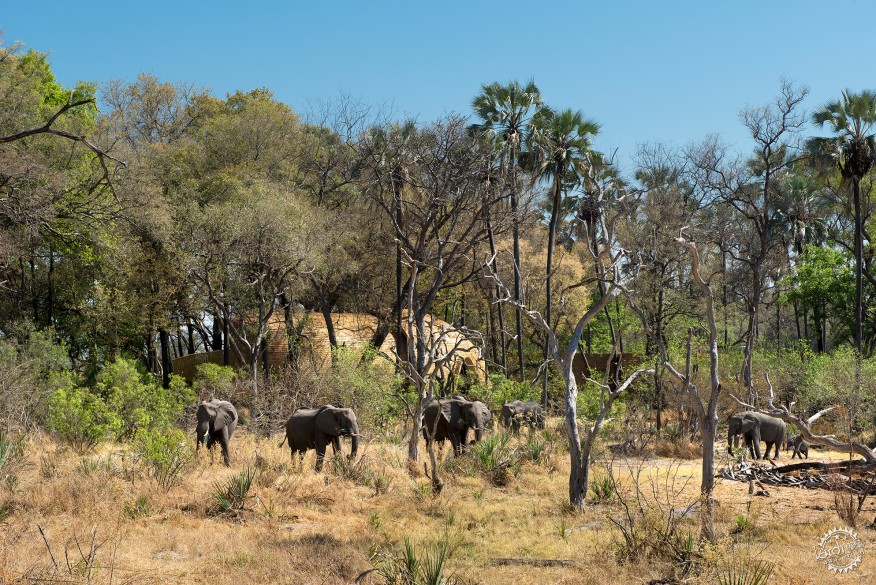
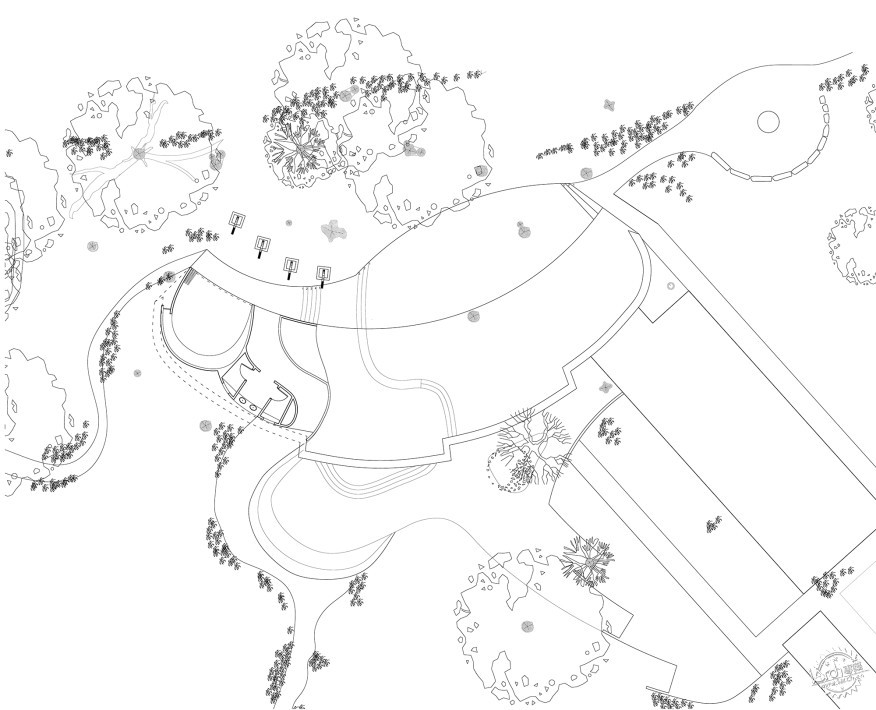
从东南方向看,建筑物外壳酷似穿山甲的鳞片甲,从窗子延伸到入口处。但从西北方向看,小屋由胶合木组成,有壁画可供欣赏,提供户外就餐。“你可以把它比作是肋骨和一些巨大的在森林中死去的野兽尸体,”Plewman说。
该选址偏僻,还有沼泽,没有围栏,是一个具有挑战性的建设工程。“没人能知道大象和狮子什么时候会这里漫步,”Plewman说。但门的不对称又让人头痛,因此很难找到制造商。他说:“在南非创造一个门式拱门,其实非常困难”。事实上,他们只在南非白河找到了一间合适的怀特河锯木厂。
每一个框架必须被分成三个部分,两只腿支撑拱的顶点,并保持指定的半径,然后加入钢板。“总的来说,存在着10种不同的半径距离,这意味着对厂家要求了10种不同的工具,“Plewman说。
Viewed from the southeast, the building shell resembles the scaly carapace of a pangolin, sweeping down to skim the ground before curving up to create entrances and fenestration. But from the northwest, where the lodge offers al fresco dining and the glulam arches are exposed to the elements, the structure is more akin to a corpse. “You could say it’s the ribs and carcass of some great beast that died in the forest,” Plewman says.
The site’s remoteness, swampland, and absence of fencing set the groundwork for a challenging construction. “You’ve got elephants and lions and who knows what walking through there at any time,” Plewman says. But the asymmetry of the portal frames caused additional headaches. Even finding a fabricator was nearly impossible. “To create a portal arch in the South African context is actually very difficult,” he says. In fact, they could find only one suitable mill, White River Sawmills, in White River, South Africa.
Each frame had to be broken into three sections—two leg supports and the arch apex— to maintain the specified radius per section and then joined with steel plates. “In total, 10 different radii were used, which meant that 10 different jigs were required by the manufacturer,” Plewman says.
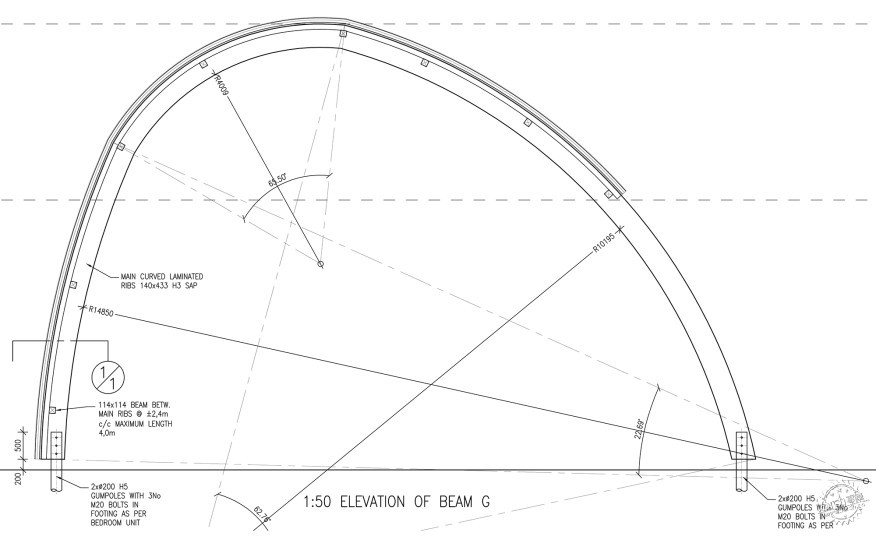
但木材运输过程需要800多英里,其中一部分需要四轮和六轮驱动车辆,至少有一半的木材已经变弯曲。“拱门再弯曲一点,就不是抛物线了,”plewman说。他考虑不用木材,“但这是不实际的。一、锯木厂可能不再经营了。二、成本将是巨大的,’’建造新的拱门也会造成重大项目延误。
在开普敦维里埃谢尔德和一些土木工程师的帮助下,建筑师将提供设计的CAD和确定新的半径,以实现平稳的形式和良好的结构。然后,当地承包商提出用一个大圆盘锯重新把胶合木框架整合。
瑕疵都是慢慢地展现出来的,然而Plewman并没有被瑕疵绊倒。他说他首先想到的是,这出于意想不到的惊喜,可以给建筑带来质感和逼真的效果。
But when the timber arrived on site after a journey of more than 800 miles, a portion of which requires four- and six-wheel-drive vehicles, at least half of the portals had warped. “[The arches] were bent open a bit so the parabolas were wrong anyway,” Plewman says. He considered rejecting the timber, but “it wasn’t practical. One, [the mill] probably would’ve gone out of business. Two, the costs would’ve been just huge.” Waiting for new arches would have also caused significant project delays.
With the help of De Villiers Sheard Consulting Structural and Civil Engineers, in Cape Town, the architects drew the supplied sections in CAD and determined the new radii that would allow for a smooth form and be structurally sound. Then, using a large circular saw, local contractor Lodge Builders Botswana re-cut the glulam frames.
The imperfections are largely imperceptible, and even Plewman isn’t bothered by them too much. Such unexpected moments, he says, can give a building texture and a more lifelike energy—which is what he wanted in the first place.
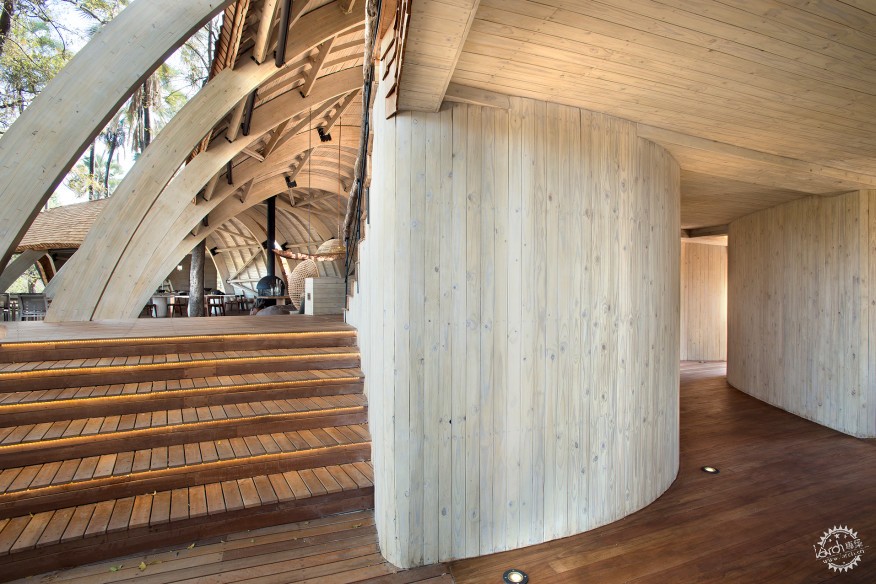
出处:本文译自www.architectmagazine.com/,转载请注明出处。
|
|
